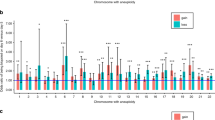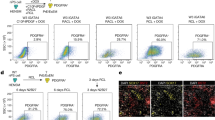Abstract
PARTHENOGENETIC mouse embryos have the potential for extensive cellular proliferation as well as differentiation into various cell types1–3. But this potential has been realised only when parthenogenetic embryos have been transferred to extrauterine sites1, and in spontaneously occurring ovarian teratomas and teratocarcinomas of parthenogenetic origin2,3. The development of mammalian parthenogenetic embryos in utero is restricted, with no conclusive evidence that they can develop to term4,5. Several hypotheses have been proposed to account for their poor development. For example, deleterious recessive genes may affect the viability of their cells, possibly because of their extensive homozygosity2,5, or disorganised growth and limited life span may result from anomalies of cellular interactions5. But the extensive cellular proliferation and differentiation of parthenogenetically derived cells which occurs in extrauterine sites is not entirely consistent with these explanations, and indicates that parthenogenones probably have a relatively stable genetic constitution. Indeed, these studies stress the likely importance of cellular environment for cytodifferentiation, provided in this instance by the extrauterine host tissue. There is a precedent for supposing that if the environment is critical for cytodifferentiation, parthenogenetic cells should be able to form chimaeras with cells derived from fertilised embryos6. Teratocarcinoma cells7,8 and cells carrying known lethal alleles9,10 can develop into viable chimaeras when aggregated with cells from normal embryos. Previous attempts to achieve development to term of aggregation chimaeras between parthenogenetic and fertilised embryos were apparently unsuccessful11. We have introduced inner cell masses (ICMs) from diploid ,parthenogenetic embryos into intact fertilised mouse blastocysts, and we report here the development of a chimaera to term.
This is a preview of subscription content, access via your institution
Access options
Subscribe to this journal
Receive 51 print issues and online access
$199.00 per year
only $3.90 per issue
Buy this article
- Purchase on Springer Link
- Instant access to full article PDF
Prices may be subject to local taxes which are calculated during checkout
Similar content being viewed by others
References
Iles, S. A., McBurney, M. W., Bramwell, S. R., Deussen, Z. A. & Graham, C. F. J. Embryol. exp. Morph. 34, 387–405 (1975).
Stevens, L. C. in The Developmental Biology of Reproduction, symp. Society Dev. Biol. 93–106 (Academic, New York, 1975).
Stevens, L. C. & Varnum, D. S. Devl Biol. 37, 369–380 (1974).
Beatty, R. A., Parthenogenesis and Polyploidy in Mammalian Development (Cambridge University, Cambridge, 1957).
Kaufman, M. H., Barton, S. C. & Surani, M. A. H. Nature 265, 53–55 (1977).
McLaren, A. Mammalian Chimaeras (Cambridge University Press, Cambridge, 1976).
Papaioannou, V. E., McBurney, M. W., Gardner, R. L. & Evans, M. J. Nature 258, 71–73 (1975).
Mintz, B. & Illmensee, K. Proc. natn. Acad. Sci. U.S.A. 72, 3585–3589 (1975).
Lyon, M. F., Glenister, P. H., Lamoreux, M. H. Nature 258, 620–622 (1975).
Mintz, B. Ann. Rev. Genet. 8, 411–470 (1974).
Graham, C. F. Nature 226, 165–167 (1970).
Surani, M. A. H. & Kaufman, M. H. Devl Biol. 59, 86–90 (1977).
Gardner, R. L. Adv. Biosci. 6, 279–296 (1971).
Chapman, V. M., Whitten, W. K. & Ruddle, F. H. Devl Biol. 26, 153–158 (1971).
Subak-Sharpe, H., Burk, R. R. & Pitts, J. D. J. Cell Sci. 4, 353–367 (1969).
Pitts, J. D. & Burk, R. R. Nature 264, 762–764 (1976).
Stevens, L. C., Varnum, D. S. & Eicher, E. M. Nature 269, 515–517 (1977).
Author information
Authors and Affiliations
Rights and permissions
About this article
Cite this article
SURANI, M., BARTON, S. & KAUFMAN, M. Development to term of chimaeras between diploid parthenogenetic and fertilised embryos. Nature 270, 601–603 (1977). https://doi.org/10.1038/270601a0
Issue Date:
DOI: https://doi.org/10.1038/270601a0
This article is cited by
-
The use of chimeric mice in studying the effects of genomic imprinting
Russian Journal of Developmental Biology (2000)
-
A human parthenogenetic chimaera
Nature Genetics (1995)
-
Proliferation and differentiation of androgenetic cells in fetal mouse chimeras
Roux's Archives of Developmental Biology (1995)
-
Teratogenic effects of parthenogenetic cells from LTXBO mice, a strain which develops ovarian teratomas at high frequency
Roux's Archives of Developmental Biology (1992)
-
Influence of parental chromosomes on spatial specificity in androgenetic ↔ parthenogenetic chimaeras in the mouse
Nature (1987)
Comments
By submitting a comment you agree to abide by our Terms and Community Guidelines. If you find something abusive or that does not comply with our terms or guidelines please flag it as inappropriate.



